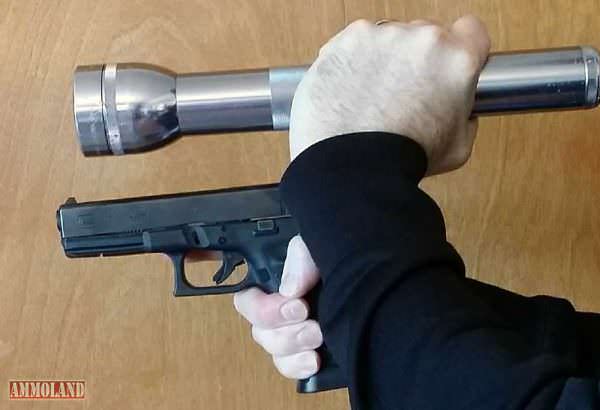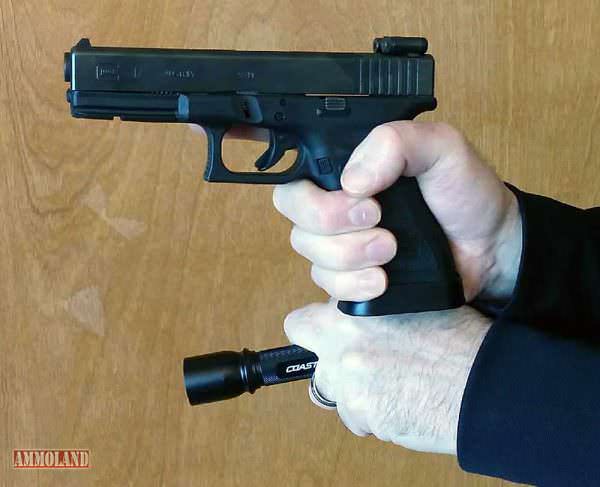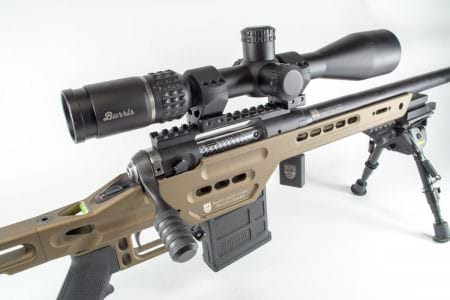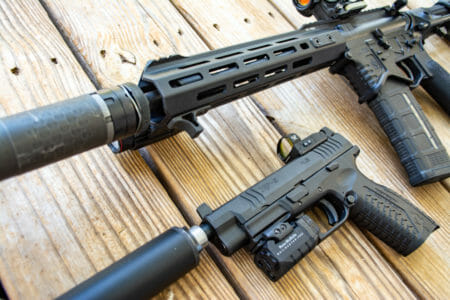By Tom McHale


USA –-(Ammoland.com)- Technology has really fouled up some of the classic gun handling techniques.
Back in the day, if you had to do scary gun stuff like investigate bumps in the night, you had a flashlight and a gun. You could use the flashlight however you liked, with little risk to anyone except the dog. If you had to shoot, you could draw or raise your gun and do that with your other hand.
To figure out ways to carry and fire a gun making the best use of both hands, enterprising gun folks developed a variety of techniques to use the light and gun together.
Those goals were basically:
- Use the flashlight to navigate and search.
- Be able to search without pointing the muzzle of your gun at unknown people or things. That’s considered rude by lots of folks.
- Be able to fire your gun without dropping your flashlight on the ground.
- Depending on the technique, you might even be able to shoot with two hands on the gun for more control, while still holding the light and keeping your target illuminated.
All of these early objectives assumed that the light and the gun were independent entities, meaning not mechanically attached or duct taped together.
Let’s take a quick look at some of the more popular techniques and then we’ll discuss why everything is now kinda broken.
Gun & Flashlight Handling Techniques


There are two basic approaches to using a gun and flashlight together. We’ll call the first general approach “one-handed-shooting-while-holding-a-light-in-the-other-hand.”
I should really be a professional namer of techniques with a crisp and concise description like that.
There are two classic methods that fall into this category.
The first is the G-man tactic, usually called the FBI technique. You hold the flashlight in your support hand like an icepick, meaning that the lens ends up on the pinky side of your hand. When you raise your hand up to face level, the lens will be pointed more or less forward, and you can control the light with a tail cap switch using your thumb. Since you’re holding the light with your support hand, it’s free to move around independently so you can do whatever you normally do with a flashlight. Your gun is in the opposite hand, and if you’re being safe, you can either keep it holstered or in a low-ready position, pointed at the floor in front of you. If you need to shoot, you do it one-handed, illuminating your target with the flashlight hand.
What was cool, at least in theory, about the FBI Technique is that bad guys were instructed in Bad Guy School only to shoot at the light so they would be shooting away from your body while you did your thing. Clever, huh?
There’s another technique usually Neck Index. It’s like the FBI Technique, except it’s for lazy people. So your hand doesn’t get tired waving the light around way off to the side where it’s a safe target for bad guys, you rest your flashlight hand up against your collarbone or under your chin. Then you operate like a tank with a huge spotlight, illuminating stuff in whichever direction your body is pointing. Like the FBI Technique, you shoot with your strong hand only.
Oh, and you have to hope your opponent skipped the class in Bad Guy School where they were instructed to shoot at the light.
Advantages of the “one-handed-shooting-while-holding-a-light-in-the-other-hand” methods are pretty clear. You can use the light as intended without pointing your gun muzzle at family members or pets. If you need to shoot, you can, you’ll just have to do it one-handed. That’s the downside.
“Shooting-With-Two-Hands-While-Awkwardly-Holding-Your-Light-And-Gun-Together” Technique

The other family of flashlight techniques is commonly called “shooting-with-two-hands-while-awkwardly-holding-your-light-and-gun-together.” The idea behind these tactics is that you hold the light in such a way that you can at least partially anchor your light hand to the gun.
The Surefire (and related) techniques call for holding your flashlight between two of your fingers using the support hand. Imagine making a fist while a flashlight is poking out forward between your ring and middle (or perhaps index and middle) fingers. Holding the light this way, you can mash up your support hand against the grip of the gun, achieving a bit more stability.
There’s a second method in this category that’s really a bit of a hybrid. To use the Harries Technique, you icepick hold the flashlight in your support hand, but anchor your support hand under your firing hand wrist. It’s kind of like a really weird cup and saucer grip. It doesn’t do much for recoil but does provide a bit of extra stability for your firing hand.

Gun & Flashlight Handling Techniques Pros & Cons
The pros and cons of the “shooting-with-two-hands-while-awkwardly-holding-your-light-and-gun-together” are this. You can get more stability while shooting because you’re using your support hand to partially anchor your firing hand. On the downside, the light and the gun tend to move and point together, so your muzzle is pointed at whatever you’re illuminating.
Here’s the problem. Now, with super small and featherweight weapon lights, you can mount a tactical light right on your handgun that has enough lumens to have their own gravitational field. For shooting, weapon lights are fantastic. You can shoot normally, using a very solid two-handed firing grip. The light is just there and illuminates everything in front of your muzzle. Once you activate the light, you can pretty much forget about it, and you don’t have to worry about holding an extra object.
The problem is that whole safely searching and navigating thing. You really don’t want to be pointing your gun at stuff that you haven’t yet seen and positively identified, and if you’re using the light mounted to your gun, you’re doing exactly that. Bad idea.
That brings us right back to the age-old idea of using a separate flashlight for searching and a mounted weapon light for shooting. If you do that, you’re still facing the tradeoffs associated with shooting with one hand because a flashlight is in the other. Hmmm…
There are a number of approaches you can consider, but none of them are really floating my boat as the perfect solution:
- Use a flashlight in your support hand and the weapon light on your gun. Live with the one-handed shooting scenario if you have to fire.
- If you bump into Godzilla in the dark, drop your flashlight and resort to using a second weapon light. The is totally counterintuitive and probably not something you’re going to do under stress, but I guess it’s an option that would, in theory, allow you to use both hands on your gun when you need to shoot.
- Search with the weapon-mounted light indirectly. As previously stated, modern gun lights are chock full of lumens, and if you point one at the floor in front of you, you’ll light up a room. In theory, without pointing your gun at anything unknown, you’ll be able to see it. The fly in the ointment is our natural tendency to point at things. If you spot something in the indirect light, your brain is most likely going to issue the following command. “Raise the light and shine it on whatever that thing is in front of me.” And we might be right back to the whole muzzling unknown people and things risk.
So there you have it. All this technology and you still have to make some tough choices.
The best way to solve these sticky little gotchas is to play cat and mouse one night. Using a blue gun, Laserlyte Trigger Tyme Laser Pistol , experiment a little to see what might work for you. Walk around your house with your light, training gun, and weapon light if you have one. If you don’t, tape a small light to your gun as a pretend option. Walk around. Open doors. Look for stuff. I promise you it will be an illuminating experience. (see what I did there?)
Read our related article : Best Everyday Carry Flashlights
About
Tom McHale is the author of the Insanely Practical Guides book series that guides new and experienced shooters alike in a fun, approachable, and practical way. His books are available in print and eBook format on Amazon. You can also find him on Google+, Facebook, Twitter and Pinterest.






I read the article and agree with many of the comments; I have seen all of these arguments before. So I had to jump in with my limited opinion. We are always looking for a solution and the author hits on some very important points but also makes some assumptions about perceived myths. From an introductory standpoint on why this is important to me, and more for vetting purposes, I am a retired LE and have been a full time trainer since 2002. I was a full time staff trainer for SureFire and later we were the Flashlight program managers… Read more »
If the bad guy is shooting back at you (that’s why you have a gun) your half way blinding light should be as far to the outside of left as you can get it from you , as the bad guy who is blinded by the light will be shooting at the light and not you, if you hold the light in front of yourself they will still shoot at the light and hit you.. Hey their eyes are adjusted to no light and if looking at a bright light it’s the only thing they can see, and shoot at….Just… Read more »
Purpa Trader, 1) The confrontation is usually very short in time, so the illumination is brief, followed by lateral movement for evasion; 2) One of the functions on my tac-lite is a strobe, which is disconcerting when fussed upon. I leave the setting on strobe, in case I have to react to an intruder at night; 3) No-one can predict the outcome of a gunfight; all I) can di is improve the odds in my favor by using a stroboscopic tac-light. .
Icepick hold in support hand, cross wrists, press BACKS of hands against each other for a very stable grip. Excellent with tac-lights with momentary butt-cap switches.
I carry two flashlights. A Maglight XL200 for general use, map reading, finding dropped keys or fixing a flat tire. A carry a Maglight MAG-TAC for tactical combat use. There probably are better lights but I’ve got these. 300+ lumens from the MAG-TAC is good. The 10-170 lumen XL200 is handy and can serve tactically if necessary.
Weaopn mounted lights are great for cops and soldiers, but for civilians pointing a gun to identify a possible target doesn’t seem wise.
I check and replace batteries daily as necessary.
The Harries method I learned (not what is shown in the article) works best for me with a flashlight. Weapons lights are the easiest for actual shooting, but are NOT a substitute for a flashlight. Searching around your car in a parking lot with a weapons light might draw a different kind of attention than a flashlight. Pointing a weapon, when what you intend to point is a light source, raises all kinds of social and legal questions.
Comment, unless you’re a long ways from 911 response, have that safety space outlined in your home, where you and your loved ones can shelter and call 911, preferable with a defensible point , say a choke point in your home, where an intruder or intruders would need to place themselves in the direct line of fire to reach you and wait for law enforcement.
Despite the concerns mentioned about a weapon-mounted light, I believe they are much safer as it is part of your one-piece system, and no fumbling around with a secondary tool. Most of the pistol lights are very bright and have a sufficient amount of spill, that will illuminate your room or general area, that will give you a clear visual of individuals around you — i.e. “friendlies” that will aide you to prevent pointing your muzzle in their direction. Train with your system, and you will find that weapon-mounted lights provide many more benefits against a secondary device. In the… Read more »